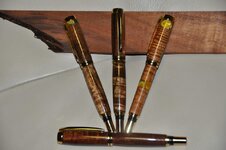Hey guys,
I have a "new turner" question regarding acrylics. You know how YouTube makes everything seem so easy? Well, I was inspired to take a crack at throwing some "bling" into some pens I'm making. I used 5-minute epoxy and joined up some acrylic/wood pen blanks I plan to turn tomorrow.
I squared up the segments, roughed up the sides to be joined with sandpaper, mixed epoxy in the measurements via package instructions, joined/clamped material for 15 mins or so each, and have the blanks sitting overnight to finish hardening.
Here's the question, what tips do you have on drilling, turning or sanding that might keep me from making simple yet significant mistakes (assuming it's not already too late for that)?
Thanks in advance for your inputs!
J
I have a "new turner" question regarding acrylics. You know how YouTube makes everything seem so easy? Well, I was inspired to take a crack at throwing some "bling" into some pens I'm making. I used 5-minute epoxy and joined up some acrylic/wood pen blanks I plan to turn tomorrow.
I squared up the segments, roughed up the sides to be joined with sandpaper, mixed epoxy in the measurements via package instructions, joined/clamped material for 15 mins or so each, and have the blanks sitting overnight to finish hardening.
Here's the question, what tips do you have on drilling, turning or sanding that might keep me from making simple yet significant mistakes (assuming it's not already too late for that)?
Thanks in advance for your inputs!
J

